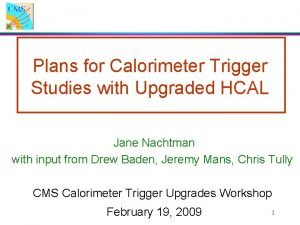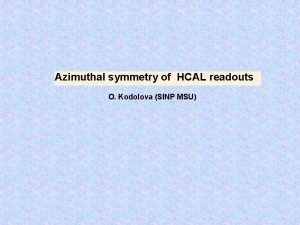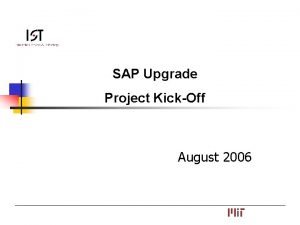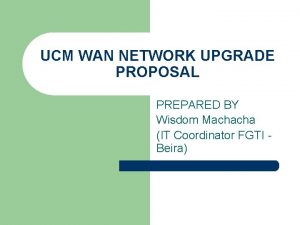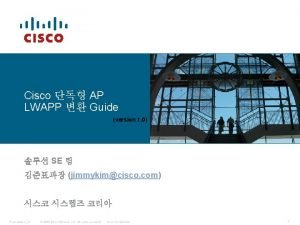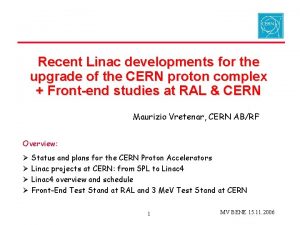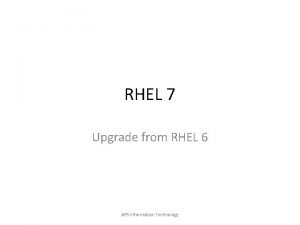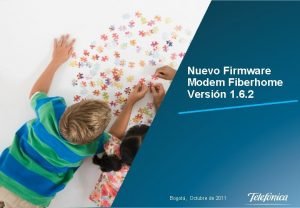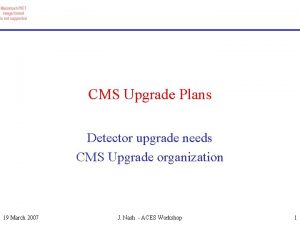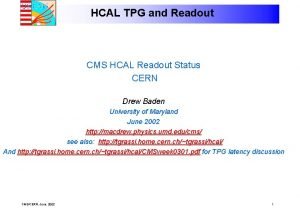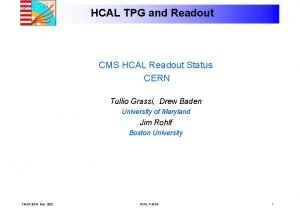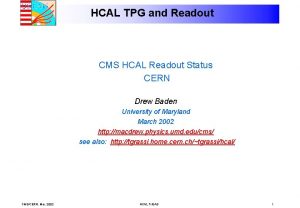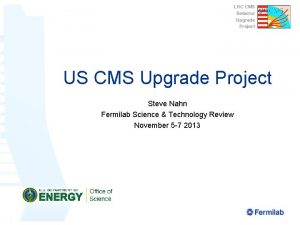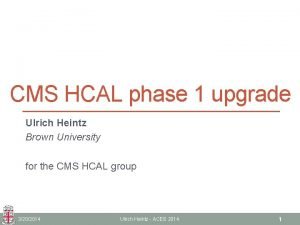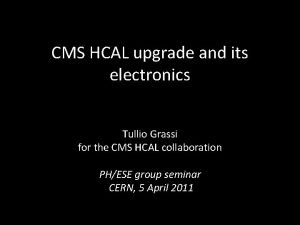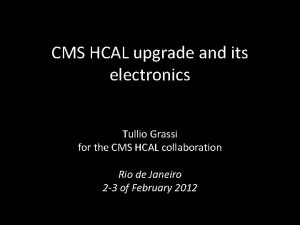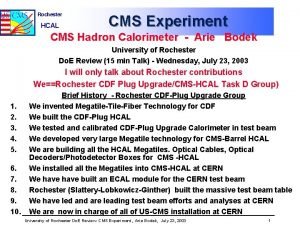Upgrade Workshop H C A L CMS HCAL















- Slides: 15

Upgrade Workshop H C A L CMS HCAL Working Group FE Electronics: New QIE Nov 20, 2007 People interested in QIE 10 development: Chris Tully, Jim Freeman, Sergey Los, Rick Vidal, Julie Whitmore QIE 8 ASIC Engineers: Tom Zimmerman, Jim Hoff (FADC) CMS Upgrade Workshop – Nov 20, 2008 1

QIE 8 Description H C A L Current QIE 8 Charge Integrator Encoder 4 stage pipelined device (25 ns per stage) charge collection settling readout reset Inverting (HPDs) and Non-inverting (PMTs) Inputs Internal non-linear Flash ADC Outputs 5 bit mantissa 2 bit range exponent 2 bit Cap ID CMS Upgrade Workshop – Nov 20, 2008 2

Current QIE 8 Operation QIE Design Specifications • Clock > 40 MHz • Must accept both polarities of charge • Charge sensitivity of lowest range – 1 f. C/LSB(invertinginput) • In Calibration Mode 1/3 f. C/LSB • Maximum Charge – 9670 f. C/25 ns(invertinginput) • Range (1 -10, 297 f. C) • 4500 electrons rms noise • FADC Differential Non. Linearity <. 05 LSBs • Package - 64 pin TQFP CMS Upgrade Workshop – Nov 20, 2008 H C A L QIE 8 - AMS 0. 8 m bi-CMOS process Chip Size: 3. 07 mm x 4. 35 mm 3

QIE 8 Response H C A L CMS Upgrade Workshop – Nov 20, 2008 4

H 6 Channel QIE 8 FE Board Custom ASICs QIE (6 / board) Fermilab C A AD 590 Temp Sensor Low Voltage Regulator (2 / board) CERN Developed in rad hard process L P 82 B 96 I 2 C Transceiver (change to P 82 B 715) MC 100 LVELT 23 LVPECL-LVTTL Honeywell VCSEL HFE 419 x-521 (2/board) [back side of board] CCA (3 / board) Fermilab MC 100 LVEP 111 LVPECL clock fanout chip Gigabit Optical Link [GOL] (2 / board) CERN Developed in rad hard process PZT 222 A transistor CMS Upgrade Workshop – Nov 20, 2008 OP 184 bi-polar Op. Amp 5

QIE 10 12 -Channel Cards H C A L GOL Quad QIE 10 Rad Hard FPGA (TDC/CCA) Quad QIE 10 GOL CMS Upgrade Workshop – Nov 20, 2008 6

QIE Data H C A L Current Configuration - 1. 6 Gbps/fiber Each RBX - 72 QIE channels/RBX (72 towers) 18 channels/RM (3 cards, 6 QIE channels, 2 fibers/card. 3 QIEs/fiber) 1 QIE = 5 -bit Mantissa, 2 -bit range, 2 -bit Cap. ID = 9 -bits 32 -bits/fiber, 1. 6 Gbps (8 -bit/10 -bit), Gigabit Ethernet New Configuration - 3. 2 Gbps/fiber Each RBX - 72 towers Tower - 3 layers (1 inner, 2 inter-weaving outer) Each Tower (3 QIEs) - Total 32 -bits 1 QIE - 6 -bits, 2 -bit range = 8 -bits (x 3) TDC - 5 -bit (per tower) Cap. ID - 2 -bit (per tower) Error Bit - 1 bit (per 3 QIEs) Each Fiber - 2 Towers (6 QIEs = 3. 2 Gbps/fiber) Use 4 cards and all 8 fibers in ribbon CMS Upgrade Workshop – Nov 20, 2008 7

Quad QIE 10 Specs QIE 10 • Clock > 40 MHz • Match to Si. PM response • HB - ZETEC 40, 000 pixel device • 4 X Dynamic range of QIE 8 • 1 Extra bit resolution (5 --> 6) • Keep non-linear response as in QIE 8 • Charge sensitivity of lowest range • QIE 8: Norm - 1 f. C/LSB, Calib - 1/3 f. C/LSB • QIE 10: 10 x less sensitive H C A L • Set by lowest Si. PM gain (Singapore ZETEC - HB? ) • Need to control rate effects (DC coupling) • 2 or 4 QIE 10 per package, either multi-channel QIE die or separate dice in single package • Form a “discriminated signal” to send to the FPGA for TDCing • 1 TDC signal per channel CMS Upgrade Workshop – Nov 20, 2008 8

Quad QIE 10 - Tom. Z H C A L QIE 10 Design Discussions w/ Tom Zimmerman (Tully/Freeman/Los) • Will 0. 8 m AMS Process still exist for QIE 10? • Tom will check with AMS • Prefers negative polarity for better impedance control • Try for 25 impedance • try for small dynamic impedance to avoid time slewing of inverting QIE 8 input • Prefers DC coupling • 1 more bit of dynamic range seemed doable • Not much more power needed (<< x 2) CMS Upgrade Workshop – Nov 20, 2008 9

Plans H C A L QIE 10 R&D • Need 100, 000 channels (60, 000 channels + spares) • Need production run such that we have chips in hand by 2011 • Probably 2 submissions: 1)Prototype, 2)Production • Tom. Z can start to work on this in March 2009 ---> Need QIE 10 spec from HCAL well in advance • Issues: • Need to check radiation hardness of AMS process • CMOS registers die from TID at 200 k. Rad (3. 5 E 12). Need to test beyond this and try accelerated annealing • Bipolar - Beta for npn-transistors dropped by 5 -10% after equivalent of 5 E 11 n/cm 2 • Have we decided on ZETEC (since this drives the dynamic range of the device)? CMS Upgrade Workshop – Nov 20, 2008 10

QIE Radiation Tolerance (from SEU ASIC studies) AMS – Most sensitive register (Minimum size + guard ring) H C A L HP and AMS registers (Minimum + guard ring) Device failure from TID (~200 k. Rad) Number of upsets per reading increases with threshold shift from TID CMS Upgrade Workshop – Nov 20, 2008 11

H Bi-polar Radiation Studies for QIE C A L Bi-polars from AMS 0. 8 m bi-CMOS process • Beta for npn-transistors dropped by 5 -10% after equivalent of 5 E 11 n/cm 2 Pre-irradiation Post-irradiation (6 weeks) b = 95. 1 Beta b = 104 Operating point – 10 A Current CMS Upgrade Workshop – Nov 20, 2008 Operating point – 10 A Current 12

FE Board Test H C A • SEU measurement is limited by data rate • Several pathologies • Signals in QIE in front of integration caps (signal & reference) • Signals in QIE on back of end caps (signal follows cap) • SEU events Pedestal Events ADC counts Evts: 1 slice > 5 ct above ped Frequency FE Board response in 200 Me. V proton beam # Time Slices/ADC Count L Summed charge Per event (not ped sub: Ped ~80 f. C) Charge (f. C) CMS Upgrade Workshop – Nov 20, 2008 13

FE Rad Data Pathologies H C A L Run 2059: Event 21191 ADC Counts/Slice ~29 f. C SEU in QIE Mantissa: 4 ct Range Bit 0 1 Positive Pulse in QIE Time Slice (25 ns/slice) Negative Pulse in QIE (pulse on Reference Input) ADC Counts/Slice Run 2059: Event 51129 SEU in QIE Mantissa 0101 1101 Time Slice (25 ns/slice) CMS Upgrade Workshop – Nov 20, 2008 14

Protons Interacting in QIE H C A L • MIP in Si (28 k-30 k e-) per 300 m • Expect maximum energy deposition (16 f. C -1. 6 p. C) based on previous measurement of protons interacting in HPD silicon but also consistent with Monte Carlo simulations • We see 60 -70 f. C in the PEAK slice HCAL implications • These events (also expected in HPD silicon) will be ignored at trigger level since the energy is deposited in a single isolated channel Evts: 1 slice > 5 ct above ped Frequency Pulses in QIE consistent with protons interacting in QIE silicon (~10 mils thick) Summed charge Per event (not ped sub: Ped ~80 f. C) Charge (f. C) CMS Upgrade Workshop – Nov 20, 2008 15
 Hcal
Hcal Azimuthal symmetry
Azimuthal symmetry Utwente
Utwente Network upgrade proposal
Network upgrade proposal Maximo upgrade
Maximo upgrade Cisco ios upgrade planner
Cisco ios upgrade planner Enmax generation ehs
Enmax generation ehs Upgrade 2003 to 2008
Upgrade 2003 to 2008 Autonomous to lightweight mode upgrade tool
Autonomous to lightweight mode upgrade tool Upgrade bene
Upgrade bene Rhel 6 to 7 upgrade
Rhel 6 to 7 upgrade Fiberhome hg6243c firmware download
Fiberhome hg6243c firmware download Are vip seats at vue worth it
Are vip seats at vue worth it Ellucian banner upgrade consultant
Ellucian banner upgrade consultant Ake upgrade
Ake upgrade Database upgrade project plan
Database upgrade project plan
